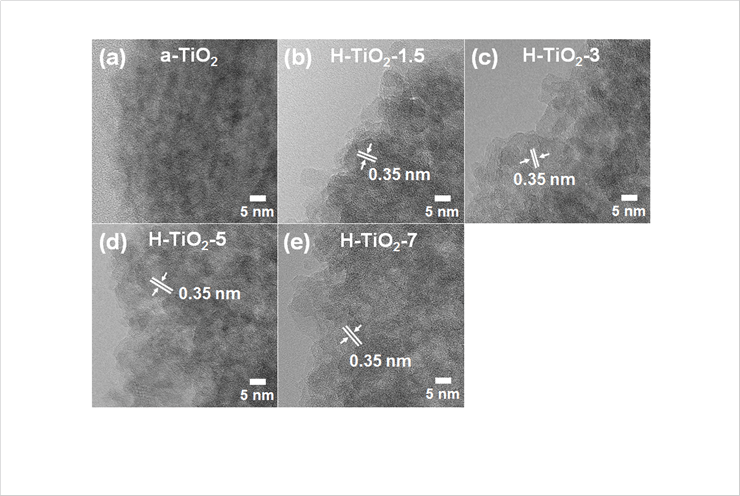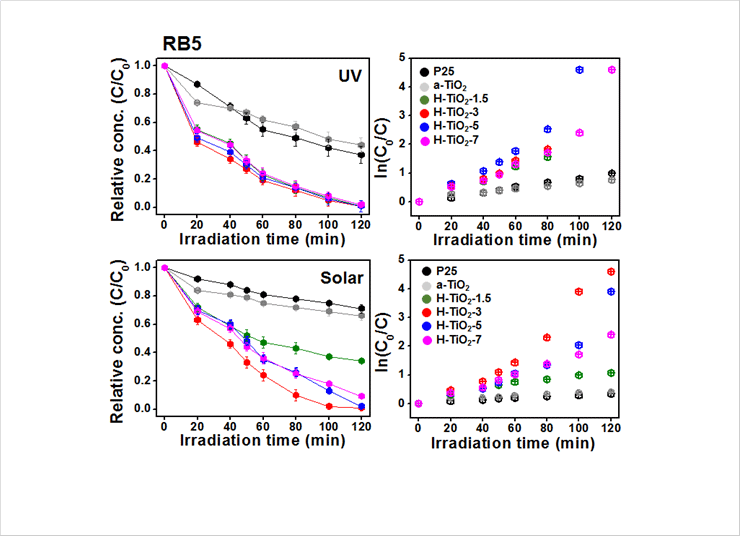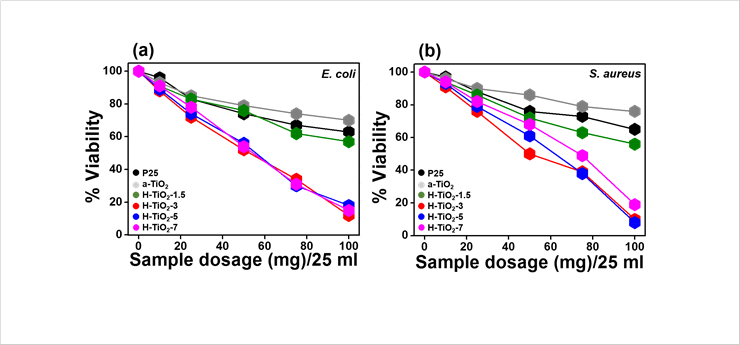Representative Research Publications
2017 > Representative Research Publications > Research Results Home
Nanoporous hydrogenated TiO2 photocatalysts with high reactivity to solar light by underwater discharge plasma treatment
- Applied Catalysis B: Envrionmental / 2017 August
- Lee, Hyun Uk (corresponding author)
Study Summary
We report on the mass production, characteristics and application of a hydrogenated TiO2 photocatalyst (H-TiO2) with high reactivity under solar light irradiation. The H-TiO2 photocatalyst has been prepared by simple underwater discharge plasma treatment at room temperature and atmospheric pressure. The optical absorption spectrum of TiO2 can be extended from the ultraviolet (UV) into the visible range by changing the surface properties. The crystallinity, hydrogenation and porosity of TiO2 can be greatly enhanced within 90s through underwater discharge plasma, using amorphous TiO2 (as-synthesizedTiO2, a-TiO2) as the precursor. The resultant H-TiO2 showed high bicrystalline (anatase/brookitephases) and a large surface area (267.5m2/g), thus improving photocatalytic activity. We have demonstrated that H-TiO2 showed significant photocatalytic efficiencies for degradation of reactive black 5, rhodamine B, and phenol under solar light irradiation, up to 10 times higher than those of commercial TiO2 and a-TiO2, leading to complete water purification. Interestingly, the H-TiO2 photocatalyst also exhibited strong antimicrobial activities against Gram-negative Escherichia coli and Gram-positive Staphylococcus aureus under solar light irradiation, up to 5-times greater than those of commercial TiO2 and a-TiO2. Given that H-TiO2 can be mass produced and easily processed by underwater discharge plasma, we expect this plasma technology may find important environmental and medical applications.
Expected Effects
It is significant that eco-friendly H-TiO2 photocatalysts with high crystallinity and porous structure were mass produced using a single process of underwater discharge plasma treatment at room temperature and atmospheric pressure. In order to effectively utilize the solar light in the field of water purification, it is very important to effectively decompose the organic contaminants under the visible light irradiation. Consequently, H-TiO2 photocatalysts showed highly efficient degradation performances, and excellent efficiencies for disinfection of E. coli and S. aureus under solar light irradiation. We believe that the development of underwater plasma systems based on H-TiO2 photocatalysts holds excellent promise for environmental and antibacterial applications.
 Figure 1. HR-TEM images of H-TiO2. (a) a-TiO2 (underwater plasma treatment time: 0 min), (b-e) H-TiO2-1.5, H-TiO2-3, H-TiO2-5, H-TiO2-7 (underwater plasma treatment time: 1.5 min, 3 min, 5 min, 7 min).
Figure 1. HR-TEM images of H-TiO2. (a) a-TiO2 (underwater plasma treatment time: 0 min), (b-e) H-TiO2-1.5, H-TiO2-3, H-TiO2-5, H-TiO2-7 (underwater plasma treatment time: 1.5 min, 3 min, 5 min, 7 min).
 Figure 2. Removal of RB 5 (which are pollutants) to evaluate the photocatalytic performance of H-TiO2. ln(C0/C), the degradation rate, is related to the degradation efficiency and the higher value is, the larger amount of dye decomposition.
Figure 2. Removal of RB 5 (which are pollutants) to evaluate the photocatalytic performance of H-TiO2. ln(C0/C), the degradation rate, is related to the degradation efficiency and the higher value is, the larger amount of dye decomposition.
 Figure 3. Plots of cell viability (%) versus solar light irradiation time (min) for
H-TiO2 photocatalysts against (a) E. coli and (b) S. aureus.
Figure 3. Plots of cell viability (%) versus solar light irradiation time (min) for
H-TiO2 photocatalysts against (a) E. coli and (b) S. aureus.



